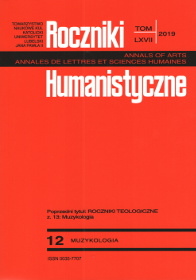Ponadkonfesyjny model działalności śląskich organmistrzów w XIX i w początkach XX wieku na przykładzie działalności Moritza Roberta Müllera oraz Carla Volkmanna i Ernsta Kurzera
A Supradenominational Model of Activity of Silesian Organ Builders in the 19th and Early 20th Centuries on the Example of the Activities of Moritz Robert Müller, Carl Volkmann and Ernst Kurzer
Author(s): Franciszek KoenigSubject(s): Fine Arts / Performing Arts, Music
Published by: Towarzystwo Naukowe KUL & Katolicki Uniwersytet Lubelski Jana Pawła II
Keywords: Silesia; organs; organ builders; organ building; ecumenism
Summary/Abstract: Since the Reformation in the 16th century, Silesia became and remained a place of coexistence of many Christian denominations. In the past, differences between particular denominations generated all sorts of tensions and even conflicts. However, in many dimensions of social, economic and cultural life, there was “practical ecumenism.” Its essence was the fact of supradenominational actions being the moment of cooperation regardless of one’s faith. That, among others, happened in the field of organ construction which contributes to an extraordinary cultural richness of the tradition of Lower and Upper Silesia. This article presents examples of this mode of operation from the 19th and the beginning of the 20th centuries. For example, a Wrocław’s builder Moritz Robert Müller was chosen from among Lower Silesian organ makers, and from the group of Upper Silesian organ makers, two cooperating builders from Gliwice served as examples: Carl Volkmann and Ernst Kurzer. They all built organs in both Catholic and Evangelical churches. The work model they used shows that in the then environment, very sensitive to music, it was not the organ builder’s religion that mattered, but only his competence.
Journal: Roczniki Humanistyczne
- Issue Year: 67/2019
- Issue No: 12
- Page Range: 131-139
- Page Count: 9
- Language: Polish

